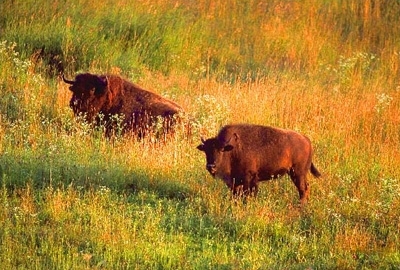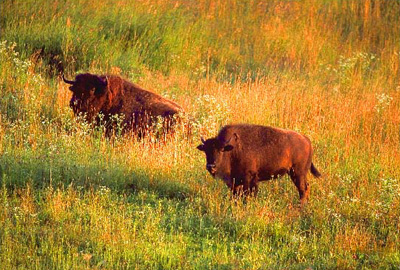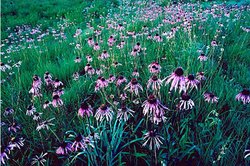Central tall grasslands
The Central tall grasslands extend over southern Minnesota, most of Iowa, an element of eastern South Dakota, and present as a narrow finger through eastern Nebraska and northeastern Kansas in the USA. This ecoregion is within the Nearctic ecoregion category. The tallgrass prairie of the USA and Canada is divided into three ecoregions: the Central, Northern, and Flint Hills tall grasslands. Agricultural conversion and development of wind farms have brought considerable habitat destruction to this ecoregion.
The Central tall grasslands are the most mesic of the grasslands of the central plains of North America. It can be distinguished from other grassland associations by the dominance of tallgrass species–a feature once relatively uniform across its range–and by the highest levels of precipitation (100 centimeters per annum). The Central tall grasslands also has the longest growing season of the ecoregions of the Great Plains. How historically abundant American Bison (Bison bison) were is not entirely clear, but Elk (Cervus elaphus) were likely very important to this ecoregion in times prior to human settlement circa 13,000 years before present.
The Central tall grasslands is distinguished from the Northern tall grasslands by a much higher diversity of species and by the presence of more northerly species in the Northern tall grasslands. The Central tall grasslands is demarcated from the Flint Hills tall grasslands to the south by soil type. The rocky, limestone [[soil]s] of the Flint Hills made that ecoregion unsuitable for intensive agriculture. The soils of the Central tall grasslands presented no such constraints to intensive farming and are now virtually converted to corn and soybean production. Historically, fire, drought and grazing by American Bison and other native ungulates were the principal sources of habitat disturbance in this ecoregion.
Biological Distinctiveness
The Central tall grasslands were likely one of the most visually appealing ecoregions of North America in their original state. Before being settled by humans and converted to agriculture, it was the largest tallgrass prairie on Earth. The large number of brightly flowering herbaceous plants added greatly to the plant diversity as well as to its physical beauty. The dominant grass species in this ecoregion are Big Bluestem (Andropogon gerardii), Old Switch Panic Grass (Panicum virgatum), and Yellow Indian grass (Sorghastrum nutans). The richness of the herbaceous cover is obvious across this ecoregion: about 265 species constitute the bulk of the tallgrass prairie in Iowa; 237 species were recorded in a square mile near Lincoln, Nebraska and 225 species were recorded from the Missouri River Valley. Many of the plant species found here originated from several different regions; having been exposed to a wide range of climates over the long term, they exhibit relatively wide ecological ranges and thus are widespread throughout the Great Plains.
Because the Great Plains grasslands attained their current extent only in the post-glacial period, these associations are characterized by very low endemism in plants and animals. Attenuated endemism is also characteristic of adjacent grassland ecoregions. As in the case of certain other ecoregions of this section of North America, American Bison and Elk once roamed these tallgrass prairies, where they were hunted by the prairie wolf (Canis lupus). All these large mammalian species are now extirpated in this ecoregion.
Amphibians
Central tall grasslands hold a number of amphibian taxa, including Cope's Gray Treefrog (Hyla chrysoscelis); Great Plains Toad (Anaxyrus cognatus), a fossorial anuran typically found in stream valleys; Bronze Frog (Lithobates clamitans), found typically on banks of lentic streams; Northern Leopard Frog (Lithobates pipiens), an anuran found in vegetated habitats near permanent water bodies and the leopard frog best adapted to extreme cold; Pickerel Frog (Lithobates palustris), found in turbid warm waters; and Northern Cricket Frog (Acris crepitans), a species typically found at edges of waterbodies with submerged vegetation.
Reptiles
Reptilian taxa in the ecoregion are represented by the Broad-headed Skink (Plestiodon laticeps); Dekay's Brown Snake (Storeria dekayi), a species often found in moist soils under rocks; Eastern Hognose Snake (Heterodon platirhinos); False Map Turtle (Graptemys pseudogeographica); Five-lined Skink (Plestiodon fasciatus); Fox Snake (Pantherophis vulpinus);
Avifauna
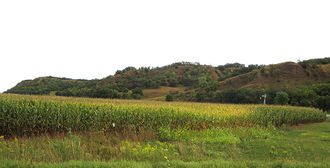 Corn fields take over the grasslands, Loess Hills, Iowa. Source: Bill Whittaker Typical avian species found in the Loess Hills part of the ecoregion include Red-tailed Hawk, Sharp-shinned Hawk, Cooper's Hawk (Accipiter cooperii), Peregrine Falcon, Ferruginous Hawk, Swainson's Hawk (Buteo swainsoni), Osprey (Pandion haliaetus), Northern Harrier (Circus cyaneus), American Kestrel (Falco sparverius), and Bald Eagle (Haliaeetus leucocephalus). In all, 20 species of raptor have been identified in this single localized portion of the Central tall grasslands. Raptors play a fundamental balance in grassland communities for regulating the populations of large numbers of species of reptiles and amphibians as well as small mammals.
Corn fields take over the grasslands, Loess Hills, Iowa. Source: Bill Whittaker Typical avian species found in the Loess Hills part of the ecoregion include Red-tailed Hawk, Sharp-shinned Hawk, Cooper's Hawk (Accipiter cooperii), Peregrine Falcon, Ferruginous Hawk, Swainson's Hawk (Buteo swainsoni), Osprey (Pandion haliaetus), Northern Harrier (Circus cyaneus), American Kestrel (Falco sparverius), and Bald Eagle (Haliaeetus leucocephalus). In all, 20 species of raptor have been identified in this single localized portion of the Central tall grasslands. Raptors play a fundamental balance in grassland communities for regulating the populations of large numbers of species of reptiles and amphibians as well as small mammals.
Prehistory
Catlinite has been prehistorically quarried and worked to produce ceremonial pipes, important to traditional Plains Indian religious practices. The quarries, commemorated by the National Pipestone Monument, are sacred to several tribes including the Dakota, Lakota, and otherNative Americans; in early periods many centuries ago these quarries were deemed neutral territory where various tribes could quarry stone for ceremonial pipes; however, it is thought that Sioux tribes may have driven out Plains tribes and aggressively seized control of the quarries circa 1700, before arrival of European settlers.
Conservation Status
Habitat Loss and Degradation
The Central tall grasslands is now the corn belt of the USA. Nearly all of this ecoregion has been converted to tilled crop land and the rest is used for haying and pasture.
Remaining Blocks of Intact Habitat 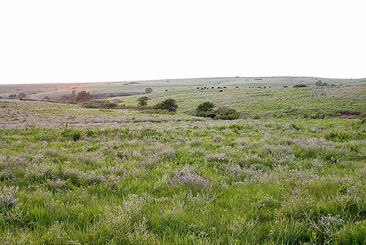 Konza Prairie Preserve, Flint Hills, Kansas. Source: Creative Commons
Konza Prairie Preserve, Flint Hills, Kansas. Source: Creative Commons
Essentially no sizeable blocks of intact habitat exist in this ecoregion. Remnants of the Central tall grasslands in southern Iowa and adjacent Missouri are restricted to 20 patches, all less than 0.08 km2 (20 acres) in size. The Loess Hills in western Iowa (16 km2) and the Prairie Coteau in eastern South Dakota contain important remnants, although the former is rather linear in shape and grazed by livestock. The Konza Prairie Preserve in the Flint Hills of northeast Kansas is the largest extant intact tallgrass prairie in North America.
Degree of Fragmentation
Fragmentation is considerable in this ecoregion, thus resulting in few, widely scattered parcels of tallgrass prairie.
Degree of Protection
Few of the remaining land fragments have formal protection, although restoration is underway at Walnut Creek National Wildlife Refuge in central Iowa. The Squaw Creek National Wildlife Refuge is a federally protected area in the vicinity of the Loess Hills.
Types and Severity of Threats
Because this ecoregion is virtually converted, future threats to the remaining tiny fragments are particularly significant. For example, the Loess Hills is one of the most important extant units of habitat, and yet this area has been significantly impacted by development of a wind farm. Wind turbines have already exacted a major toll on native birdlife, especially raptors who rely upon the same thermals that the wind turbines target. Continued operation of this windfarm and others in the ecoregion is a threat to the native raptor species and hence on the entire ecosystem, since raptors are keystone species here.
Suite of Priority Activities to Enhance Biodiversity Conservation
- Working with appropriate agencies, efforts should be made to protect and restore the remaining fragments. This will be an arduous effort in most areas and perhaps futile in others, because of the high value of the land for agricultural purposes.
- An example of an appropriate target for this approach would be the Prairie Coteau, which could be restored to an area as large as 162 km2.
Conservation Partners
- Clinton Owensby, authority on the USA Tall grass prairie
- Missouri Resource Assessment Partnership
- The Nature Conservancy, Iowa Field Office
- United States Fish and Wildlife Service
Relationship to other classification schemes
Tallgrass prairie is a biome derived from Sims. It corresponds to Küchler unit no. 66 (Bluestem Prairie), and Omernik ecoregion 47 (Western Corn Belt plains). The tallgrass prairie defined above generally corresponds to Bailey as parts of sections 251B (North Central Glaciated plains Section), 251C (Central Dissected Till plains Section), and 222M (Minnesota and NE Iowa Morainal, Oak Savanna Section).
References
- J.M. Hoekstra, Molnar, J. L.; Jennings, M.; Revenga, C.; Spalding, M. D.; Boucher, T. M.; Robertson, J. C.; Heibel, T. J. et al. (2010). Molnar, J. L., ed. The Atlas of Global Conservation: Changes, Challenges, and Opportunities to Make a Difference. University of California Press. ISBN 978-0-520-26256-0
- National Research Council (USA). Water Science and Technology Board. 2008. Mississippi river water quality and the Clean Water Act: progress. National Research Council Committee on the Mississippi River and the Clean Water Act.. 239 pages. Google eBook
- John S. Sigstad (1970) A Field Test for Catlinite. American Antiquity 35:3. pp. 377–382.
- Diane R. Witte, Walnut Creek National Wildlife Refuge and Prairie Learning Center, Restoration and Reclamation Review, 1, 1, Spring 1996
| Disclaimer: This article contains some information that was originally published by the World Wildlife Fund. Topic editors and authors for the Encyclopedia of Earth have edited its content and added new information. The use of information from the World Wildlife Fund should not be construed as support for or endorsement by that organization for any new information added by EoE personnel, or for any editing of the original content. |
